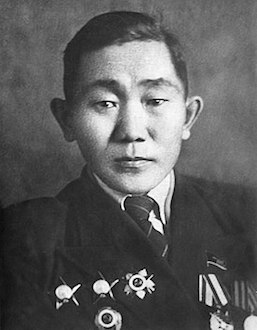Fyodor Okhlopkov facts for kids
Quick facts for kids
Fyodor Matveyevich Okhlopkov
|
|
|---|---|
 |
|
| Born | 3 March 1908 Krest-Khaldzhay, Russian Empire |
| Died | 28 May 1968 (aged 60) Krest-Khaldzhay, Yakut ASSR, Russian SFSR, Soviet Union |
| Allegiance | |
| Service/ |
Infantry |
| Years of service | 1941 – 1945 |
| Rank | Sergeant |
| Unit | 234th Infantry Regiment |
| Battles/wars | World War II |
| Awards | Hero of the Soviet Union |
Fyodor Matveyevich Okhlopkov (Russian: Фёдор Матве́евич Охло́пков) was a brave Soviet soldier. He fought during World War II. Fyodor was an amazing sniper, known for his incredible accuracy. He is officially credited with killing 429 enemy soldiers. Even though he was a true hero, he had to wait many years for his highest award. He finally received the title Hero of the Soviet Union in 1965. This was more than twenty years after the war ended.
Contents
Early Life of Fyodor Okhlopkov
Fyodor Okhlopkov was born on March 3, 1908. He grew up in a small village called Krest-Khaldzhay. His family were Yakut peasants. Fyodor lost his parents when he was only twelve years old. He had to start working at a young age to help his family. He worked in a mine, pulling heavy loads. Later, he became a machine operator on a large collective farm.
Sharpshooting Skills
Even while working, Fyodor found time for training. He attended sharpshooting classes with an organization called Osoaviakhim. This group taught people how to shoot well. He earned a special badge called "Voroshilov shooter" for his excellent aim. He had also been a member of the Komsomol youth organization since 1929.
Fyodor Okhlopkov in World War II
In September 1941, Fyodor joined the Red Army. He started as a machine gunner. His brother, Vasily, also served in the same unit. Sadly, Vasily was killed in action in January 1942. Before becoming a sniper, Fyodor led a team of machine gunners.
Becoming a Sniper Hero
By October 1942, Fyodor became a sniper. This was because of his amazing shooting skills. He had already been wounded four times in battle. One injury was so bad he had to go to a hospital. When he returned to the front lines, he quickly became famous. He was known for his high number of kills. He rarely needed more than one shot to hit his target.
Battles and Injuries
Fyodor often had long duels with enemy snipers. He would wait patiently for them to show themselves. Then, he would fire one precise shot. Besides sniping, he also learned to use an anti-tank rifle. He even went on dangerous missions behind enemy lines. On June 7, 1944, he was nominated for the Hero of the Soviet Union award. By then, he had killed 420 enemy soldiers. However, the award was changed to the Order of the Red Banner instead.
Later that month, on June 23, 1944, Fyodor was badly wounded again. He got a severe chest injury during fighting in Belorussia. This was the twelfth time he had been wounded in battle. He was sent to a hospital to recover. His injuries were so serious that he could not fight again until spring 1945. This was just before the war ended. By the end of the war, his official sniper count was 429 enemy soldiers. He also took out 27 more with his machine gun.
Life After the War
After the war, Fyodor marched in the Moscow Victory Day parade in June 1945. Then, he left the military. When he returned home, his community welcomed him warmly. Many people wondered why he hadn't received the highest award, the Gold Star.
Postwar Work and Recognition
From 1945 to 1949, he worked for the local Communist Party committee. He also became a member of the Council of Nationalities in 1946. This was a part of the Soviet government. For several years, he managed different local businesses. From 1954 until he retired in 1960, he worked on a collective farm.
Finally, on May 6, 1965, Fyodor was given the title Hero of the Soviet Union. He also received the Order of Lenin. This was a long-awaited recognition for his bravery. He passed away a few years later, on May 28, 1968. Fyodor and his wife, Anna, had ten children. Anna was also honored with the Mother Heroine award.
Awards and Honors
- Hero of the Soviet Union (May 6, 1965)
- Order of Lenin (May 6, 1965)
- Order of the Red Banner (July 26, 1944)
- Order of the Patriotic War 2nd class (October 17, 1943)
- Two Order of the Red Star (August 27, 1942 and December 4, 1942)
- Medal "For Courage" (July 18, 1944)
- Campaign and jubilee medals
See also
 In Spanish: Fiódor Ojlópkov para niños
In Spanish: Fiódor Ojlópkov para niños

